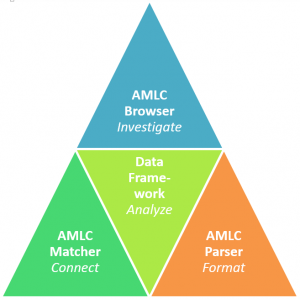Data & Analytics
Publication date 02-03-2021
The AMLC makes use of data analysis, among others, to identify new suspects, criminal networks and trends & phenomena in the field of money laundering. These insights enable the investigative capacity of FIOD (the Dutch Fiscal Intelligence and Investigation Service) to focus on cases that have the most impact on society. Moreover, it also ensures a more effective use of available sources. To perform these analyses on relevant data, the AMLC develops its own tooling based on open-source technology: the AMLC Suite.
Analyses
Both open sources (e.g. the Panama Papers) and sealed sources (e.g. the suspicious transactions reported to the FIU) are used for the performance of analyses. In selecting the sources, the decisive factor is not the quantity of the data, but the relevance of the data in terms of the fight against money laundering. It is therefore not about big data, but about relevant data. The analyses contribute significantly to AMLC’s three themes, Trade Based Money Laundering (TBML), Financial Safety and Concealed Assets. In addition, the AMLC Suite is used for the analyses of the J5.
The J5
The J5 is a partnership between the Netherlands, Australia, the United Kingdom, the United States and Canada, and was formed to tackle the enablers of tax crime. This has resulted in various action groups, including Data & Platforms, of which the Netherlands is the action group leader.
The AMLC Suite is also deployed in different Data Challenges organized by the AMLC. In a Data Challenge, an attempt is made to use data to acquire more knowledge about a chosen topic. To this end, different experts are invited to take part in multidisciplinary teams to carry out assignments. New insights are gained by mixing knowledge, experience and data. At the end of 2019, for example, there was a Data Challenge themed around TBML, where we shared knowledge about this subject and used knowledge sharing to search through suspicious transactions for TBML reports. In concrete terms, this has led to three interesting indicators that are currently being investigated further.
AMLC- Suite
Innovative, preferably open-source technology is used primarily in the development of tools. The advantage of this is that it provides good quality and fast software without any purchase costs or maintenance costs. The total set of tools is referred to as the AMLC Suite (refer to the figure below), led by the AMLC Browser flagship. The Browser enables investigating officers and analysts of FIOD to visually and interactively search through large quantities of data. Additionally, the AMLC Matcher can find relationships between different data sets at a breathtaking pace. Also, machine learning algorithms are used to find key persons in criminal networks. The J5 group did this, for example, to find addresses that could be potentially interesting for further investigation.

The AMLC Suite consists of four components:
- AMLC Browser (investigate)
- Data Framework (Analyze)
- AMLC Matcher (Connect)
- AMLC Parser (Format)
The AMLC Browser is used by investigating officers and analysts of FIOD to search through large quantities of data, in which they find links between subjects, companies and addresses.
The Data Framework is used by data analysts and data scientists to carry out analyses / processes on data. This enables them to find the key persons in the criminal network by making use of network analysis algorithms for example.
The AMLC Matcher can find relationships between different data sources at a breathtaking pace. This enables our data architects / data analysts to combine information from different data sets.
The AMLC Parser is used to put data in the correct format in the Data Framework.
AMLC Browser
The AMLC browser is developed by the AMLC. It is used to search through our data set, quickly and in a visually appealing way. Please check the video below for an explanation.
